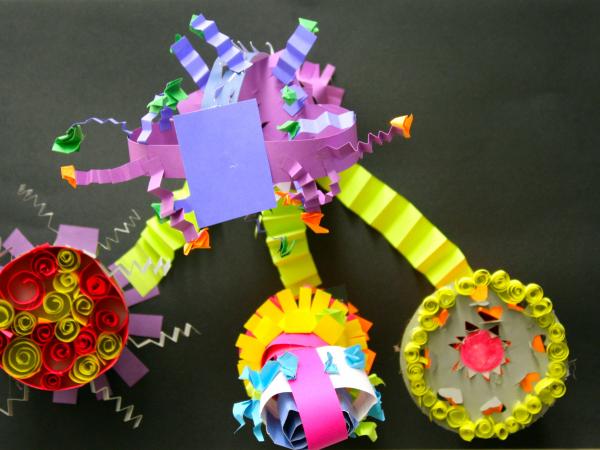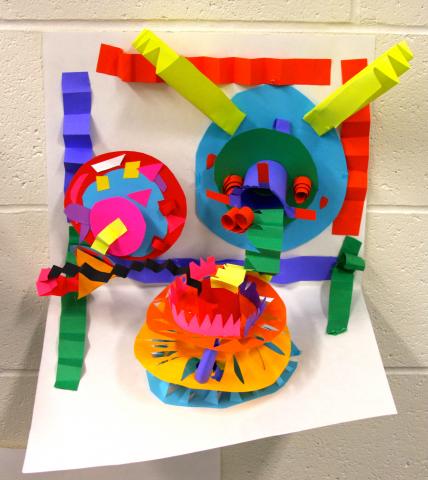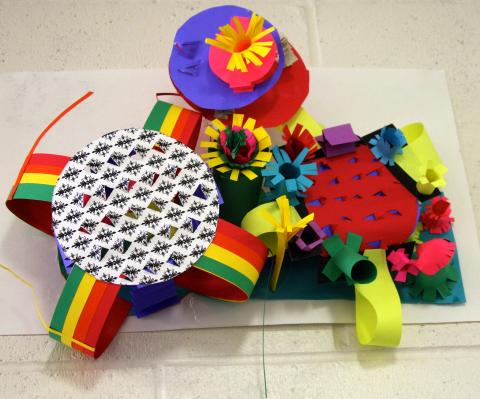Educator Resources
Mega Molecules—Scientific Sculptures

Small groups of students choose a molecule.
Then, individually, students create the elements of the molecule compound using paper manipulation techniques including kirigami and quilling. The individual elements are then combined into one sculpture to create the compound.
Objectives:
- Students will create an element
- Students will work together to create a molecule
- Students will present their work to the class
- Students will write an artist’s statement
Basic Outline of the Lesson:
- Introduce of the project
- Introduce the materials and let students experiment with them
- Students create sculptures
- In small groups, students combine sculptures to create molecules
- Students present their molecules
- Students write their artist’s statements
Art Supplies:
- Miscellaneous colored paper
- Miscellaneous colored card stock
- Pencils / erasers
- Rulers
- Cutting boards
- X-ACTO knives / blades
- Scissors
- Glue sticks
- Hot glue guns / glue gun sticks
- Tape
- Drawing paper
- Tag board for presenting molecules
Other Resources:
- Examples of paper sculptures and how to manipulate paper (kirigami and quilling)
- Molecule list
- Slide show to introduce project and related artwork (see outline at the end of the lesson plan)

Idaho State Learning Standards:
Arts and Humanities: Anchor Standard 4: Convey meaning through the presentation/performance/production of an original work or unique interpretation of a work.
- Objective PR1.1 Combine knowledge and understanding from two or more disciplines to present/perform their original or interpreted works for an audience
- Objective PR1.2 Convey meaning through their presentation/performance
Physical Sciences: PS1-MS Matter and Its Interactions
- PS1–MS–1: Develop models to describe the atomic composition of simple molecules and extended structures.
Further Explanation: Emphasis is on developing models of molecules that vary in complexity. Examples of simple molecules could include ammonia and methanol. Examples of extended structures could include sodium chloride or diamonds. Examples of molecular-level models could include drawings, 3D ball and stick structures, or computer representations showing different molecules with different types of atoms. - PS1.A: Structure and Properties of Matter
Substances are made from different types of atoms, which combine with one another in various ways. Atoms form molecules that range in size from two to thousands of atoms. (PS1-MS-1)
Academic Language:
- Subject area language: atom, compound, molecule
- Art language: paper manipulation, quilling, kirigami
Student Use of Vocabulary:
Students will use the words when creating their projects, presenting their molecules and writing their artist statements
Student Grouping:
Students will work in small groups and individually

Day 1 – Introduction
Introduce the project with a slide show (see additional resources)
Questions to ask during the slide show include:
- What do you see?
- How do you think the artists created this art?
- Why do you think the artists created this art?
- How do you think these artists used science in their art?
Explain the creative process for the project
Demonstrate paper manipulation techniques
- Kirigami (decorative paper cutting and folding)
- Quilling (rolling and gluing paper)
If time remains, students can experiment with paper techniques
Day 2 – Artmaking
Divide students into small groups based on compound /molecules and the number of elements in each
Some students can work alone if the atom has only one element
Students should begin designing and sketching their sculpture
Day 3 – Artmaking
Discuss/demonstrate how to safely use an X-ACTO knife and glue gun
Students should start working on creating their sculptures, using the paper manipulation techniques
Students should refer to their sketches when creating their elements
Day 4 – Artmaking
Students should work on creating their sculptures
Encourage the students to finish their sculptures
Day 5 – Artmaking
Students should finish their elements
Students should work in their groups to arrange and connect their sculptures on the poster board
Students should use paper manipulation techniques to connect their sculptures
Remind students to put their names on the back of the poster board
Day 6 – Presentations
Student groups should prepare to present their sculptures to the class
Students should present their sculptures to the class
At the end of the class, the teacher can collect student work to display in the hall
Day 7 – Artist Statements
Students should write their individual artists statements
Slide examples:
Our goal for this project is to facilitate the opportunity for students to identify their strengths and explore them through the metaphor of an animal. Additionally, teachers may want to implement a cultural element to promote cross-cultural exploration and connection.
We incorporated a cultural element by connecting the project to Native American tribes in Northwestern Canada.
- We used the second slide to show examples of how the different tribes used different artistic elements in their mask and totem making.
Techniques and Colors usage: we focused on techniques of form and color in how they functioned to communicate certain symbolic and cultural meanings through the masks.
- We went through different colors and their symbolic meanings.
- We also showed how different stylistic techniques are used.
- We showed how these differed from tribe to tribe.
- We also noted that students could connect their own personal meanings to colors.
A sequence of different examples of animal masks were then shown and students were asked to identify colors, techniques, and textures used.
Uses of Masks: go over how masks were used and their purpose within a cultural framework.
Choosing your spirit animal: Provide questions to encourage students in their consideration and identification of strengths.
- What are my strengths?
- What are some words that describe me?
- What do I like to do? What do I do a lot? What character traits do I poses?
- Have you ever been drawn to a particular animal or creature?
- Does a certain animal appear a lot in your life?
- Have you ever had a recurring dream in which a specific animal often appears?
Thinking about Strengths: students will get out a blank piece of paper and record their strengths, things that are important to them, and describe their personality.
- We chose to put our masks together in a totem pole-the next slide refer to that.
Creating a totem pole: Go over the why, who, and how.
- We asked students to present a monologue.
The monologue and presentation: go over what a monologue is and what the expectations are for presenting.
Reiterate Goals
Resources: Provide access to examples or artwork and ideas.
- Introduce your spirit animal
- Tell us which tribe or region it comes from in Canada
- Explain what traits it represents and how these relate to you

0 comentarios
Leave a Comment